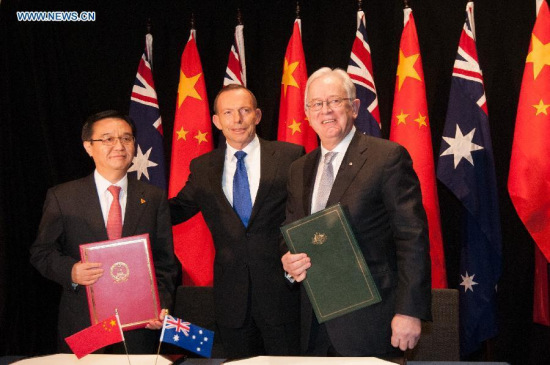
China's Commerce Minister Gao Hucheng (L) and Australia's Trade Minister Andrew Robb (R) pose for photos with Australian Prime Minister Tony Abbott after signing the China-Australia Free Trade Agreement at the National Gallery in Canberra June 17, 2015. (Photo: Xinhua/Justin Qian)
With the signing of the China-Australia Free Trade Agreement (FTA) Wednesday in Canberra, the two countries have opened a new chapter in their relationship as the FTA will greatly boost their economic cooperation.
The China-Australia FTA that covers fields such as goods, services and investment is considered as being among the free trade agreements that grant the most freedom in trade and investment.
Upon full implementation of the wide-ranging agreement, tariffs will be lifted on 95 percent of Australian exports, hurdles for Chinese businesses to invest in Australia will be lowered and more visas for Chinese holidaymakers will be granted.
It is well known that China is experiencing a "new normal" which demands economic restructuring, industrial upgrading and more opening-up. So is the Australian economy.
Under such circumstances, the FTA will help realize the economic complementarity and mutual benefit between the two countries and will play a key role in both of China's and Australia's transition.
Take commodities as an example. Though falling commodity prices and Chinese economic restructuring have raised concerns about the fading of Australia's mining boom, the volume of Australian iron ore exports to China last year remained high and reached a record of 548 million tons, increasing by 31.6 percent since 2013.
It is certain that Australia's resource exports to China will stay robust since China's dynamic industrialization and urbanization will continue for many years to come.
Moreover, a new boom in services, agriculture and infrastructure is gaining momentum. Much more potential, beyond trade, remains to be tapped in the two countries' cooperation.
China is going to import more than 10 trillion U.S. dollars' worth of goods and services and invest more than 500 billion dollars in the coming five years in Australia, Chinese Ambassador to Australia Ma Zhaoxu said earlier.
That means that China is expected to remain Australia's largest two-way trading partner in goods and services and its largest goods export destination.
Furthermore, the new agreement is a crucial step towards connecting other Asian partners with trade. As Chinese President Xi Jinping said, a closer China-Australia relationship not only benefits the two nations, but also the Asia-Pacific region.
The signing of the China-Australia FTA is of significance in promoting the process of the Regional Comprehensive Economic Partnership (RCEP) and the Free Trade Area of the Asia-Pacific (FTAAP), as well as accelerating the economic integration in the Asia-Pacific region and achieving common prosperity.
















































